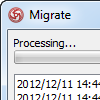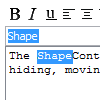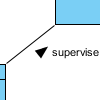 When Visual Paradigm release a new new version, it comes with many new and enhanced features. In order for a project file created in an old version to work smoothly in new version, it has to undergo a conversion process, which involve the checking and patching of project data. The conversion process is a one-off procedure done when you first open the project in new version. It may take a while to complete. So you can imagine if you are working as a team and your team have many, many projects, conversion can be a fairly daunting task.
When Visual Paradigm release a new new version, it comes with many new and enhanced features. In order for a project file created in an old version to work smoothly in new version, it has to undergo a conversion process, which involve the checking and patching of project data. The conversion process is a one-off procedure done when you first open the project in new version. It may take a while to complete. So you can imagine if you are working as a team and your team have many, many projects, conversion can be a fairly daunting task.
For this reason, Visual Paradigm introduced the mass project migration feature. It helps you convert a group of projects from old version to new version at the same time, and eventually have them committed to the server automatically. With this, you can assign one team member to execute the mass project migration. And when the migration is complete, ask the rest of the team re-checkout the projects from server. Since the projects have been converted, team members can directly open the project without having to wait for any project conversion, which saves a great deal of time.
Notice that the technique described in this article applies to any users who use Visual Paradigm’s client products (VP-UML/Agilian/Lorigizn) with any kind of supported concurrent versioning system (VP Server, SVN, CVS, Perforce, ClearCase).
Read more
 ID is a very useful property for a model elements. Having an unique ID for your model elements not just can ease the communication between your team but also help to structure your model in a more systematic way. Visual Paradigm can help you to generate unique ID for your model elements. Besides, you can apply customized patterns to the ID to accommodate your needs in different situations. In this article, we will show you how to configure the ID generator to generate customized ID for your model elements with Visual Paradigm. Read more
ID is a very useful property for a model elements. Having an unique ID for your model elements not just can ease the communication between your team but also help to structure your model in a more systematic way. Visual Paradigm can help you to generate unique ID for your model elements. Besides, you can apply customized patterns to the ID to accommodate your needs in different situations. In this article, we will show you how to configure the ID generator to generate customized ID for your model elements with Visual Paradigm. Read more
 The find feature allows you to search for specific words or sentences within text in the description editor. Finding starts from the beginning of the description, regardless of the position of text cursor. The first occurrence of text that matches with the entered search text will be highlighted. You can move to the next occurrence by clicking on the Next button. You can perform finding in all the RTF description editors, such as the description editor in specification window.
The find feature allows you to search for specific words or sentences within text in the description editor. Finding starts from the beginning of the description, regardless of the position of text cursor. The first occurrence of text that matches with the entered search text will be highlighted. You can move to the next occurrence by clicking on the Next button. You can perform finding in all the RTF description editors, such as the description editor in specification window. There are two common misunderstanding about use case modeling or
There are two common misunderstanding about use case modeling or  When Visual Paradigm release a new new version, it comes with many new and enhanced features. In order for a project file created in an old version to work smoothly in new version, it has to undergo a conversion process, which involve the checking and patching of project data. The conversion process is a one-off procedure done when you first open the project in new version. It may take a while to complete. So you can imagine if you are working as a team and your team have many, many projects, conversion can be a fairly daunting task.
When Visual Paradigm release a new new version, it comes with many new and enhanced features. In order for a project file created in an old version to work smoothly in new version, it has to undergo a conversion process, which involve the checking and patching of project data. The conversion process is a one-off procedure done when you first open the project in new version. It may take a while to complete. So you can imagine if you are working as a team and your team have many, many projects, conversion can be a fairly daunting task. In UML (Unified Modeling Language), an association can be used to represent that two classifiers which are related with each other. On any binary association, you may optionally put a solid triangular arrowhead near the name of the association to define the way the association should be read. In this article, we will see how to show the triangular arrowhead on an association in
In UML (Unified Modeling Language), an association can be used to represent that two classifiers which are related with each other. On any binary association, you may optionally put a solid triangular arrowhead near the name of the association to define the way the association should be read. In this article, we will see how to show the triangular arrowhead on an association in 